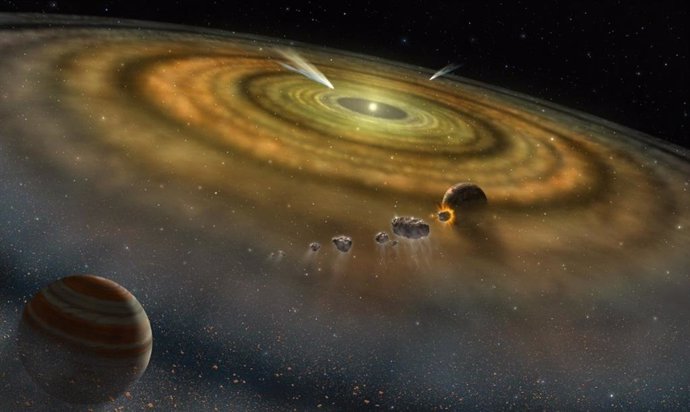Artist’s illustration of the collision between asteroids in Beta Pictoris – JONHS HOPKINS UNIVERSITY
June 10 () –
Astronomers have captured what appears to be a snapshot of a massive collision of giant asteroids in Beta Pictoris, a neighboring star system known for its tumultuous planetary formation.
The observations, recorded 63 light years from Earthhighlight the volatile processes that shape star systems like ours, offering a unique insight into the primordial stages of planetary formation.
“Beta Pictoris is at an age where planet formation in the terrestrial planet zone is still ongoing through collisions of giant asteroids, so what we could be seeing here is basically how planets are forming.” rocky bodies and other bodies in real time,” said it’s a statement Christine Chen, an astronomer at Johns Hopkins University who led the research.
The findings are now being presented at the 244th Meeting of the American Astronomical Society in Madison, Wisconsin.
Chen’s team detected significant changes in the energy signals emitted by dust grains around Beta Pictoris by comparing new data from the James Webb Space Telescope with Spitzer Space Telescope observations from 2004 and 2005. With the Webb’s detailed measurements, the team tracked the composition and size of dust particles in the exact area previously analyzed by Spitzer.
Focusing on heat emitted by crystalline silicates (minerals commonly found around young stars, as well as on Earth and other celestial bodies), scientists found no traces of the particles previously observed in 2004-05. This suggests that a cataclysmic collision between asteroids and other objects occurred about 20 years ago, pulverizing bodies into fine powder particles smaller than pollen or powdered sugarChen said.
“We think all that dust is what we initially saw in the 2004 and 2005 Spitzer data,” said Chen, who is also an astronomer at the Space Telescope Science Institute. “With Webb’s new data, the best explanation we have is that we are, in fact, witnessing the consequences of a rare cataclysmic event among large asteroid-sized bodies, marking a complete shift in our understanding of this star system.”
The new data suggests that dust that was scattered outward by radiation from the system’s central star is no longer detectable, Chen said. Initially, dust near the star heated up and emitted thermal radiation that Spitzer’s instruments identified. Now, dust that cooled as it moved away from the star no longer gives off those thermal characteristics.
When Spitzer collected the above data, scientists assumed that something like small grinding bodies would stir up and replenish the dust steadily over time. But Webb’s new observations show that the dust disappeared and was not replaced. The amount of dust kicked up is about 100,000 times the size of the asteroid that killed the dinosaurs, Chen said.
Beta Pictoris, located about 63 light-years from Earth, has long been a point of interest to astronomers because of its proximity and the random processes in which collisions, space erosion and other planet-forming factors will dictate the system destination.
Only 20 million years old (compared to our 4.5 billion-year-old solar system), Beta Pictoris is at a key age when giant planets have formed, but the terrestrial planets could still be developing. It has at least two known gas giants, Beta Pic b and c, which also influence the surrounding dust and debris.
“The question we’re trying to contextualize is whether this whole process of terrestrial and giant planet formation is common or rare, and the even more basic question: Are planetary systems like the solar system that rare?” said co-author Kadin. Worthen, a doctoral student in astrophysics at Johns Hopkins. “Basically, we’re trying to understand how weird or average we are.”





![[Img #74662]](https://thelatestnews.world/wp-content/uploads/2024/12/Organisms-with-the-shortest-life-150x150.jpg)






![[Img #74662]](https://thelatestnews.world/wp-content/uploads/2024/12/Organisms-with-the-shortest-life-300x200.jpg)


Add Comment